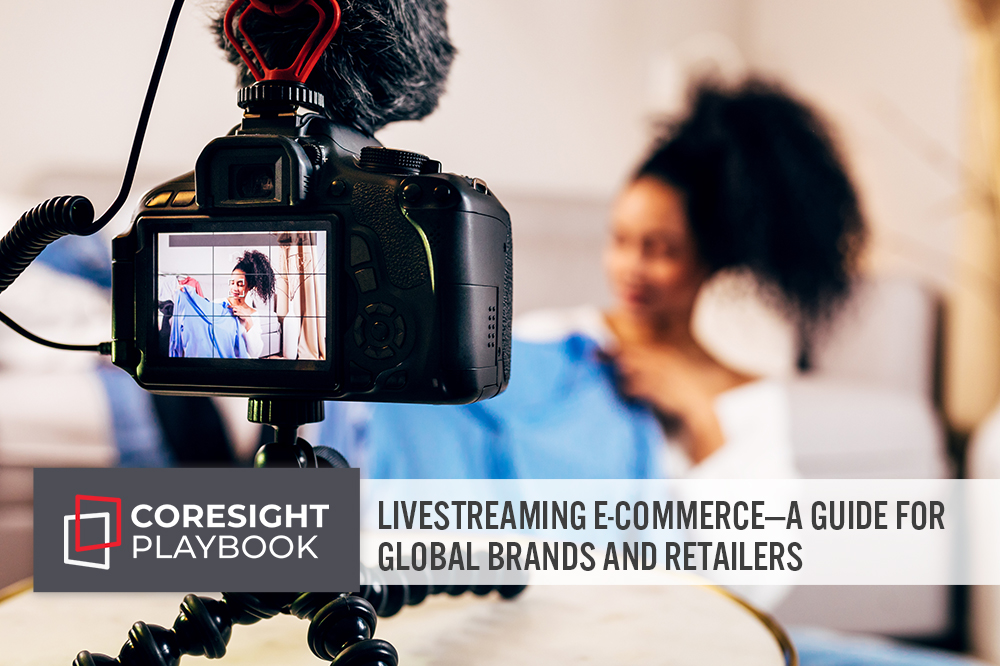
DIpil Das
What’s the Story?
The Coresight Research Playbook series provides recommendations for brands, retailers and marketplaces seeking to tap growth segments and emerging trends. Coresight Research has identified livestreaming e-commerce as one of the key trends to watch in retail.
Livestream shopping—which blends entertainment and commerce in a live-video format—is well established in China and is now becoming an essential marketing tool for brands and retailers around the world, as it provides interactive content in real time, directly engaging consumers.
In this Playbook, we present seven key strategies for brands and retailers globally to launch and enhance livestreaming capabilities. We discuss several leading disruptors in the livestreaming landscape. CommentSold, for example, enables small and medium-sized retail businesses to launch live selling across social media platforms, owned websites and branded mobile apps. For more on innovators in this space, including Smartzer and Ghost Retail, see our Retail-Tech Landscape: Livestreaming E-Commerce Tech Providers and Platforms.
Why It Matters
Live shopping is in a nascent stage in the West, and accelerated digital adoption has opened the door for livestreaming e-commerce to gain traction. Coresight Research estimates that the US livestreaming e-commerce sector, for example, will total $26 billion by 2023—up from an estimated $11 billion in 2021.
Livestreaming e-commerce enables brands and retailers to expand their digital presence, extend their reach to untapped markets and customer segments, and connect with consumers in a personalized manner. The channel can be adopted by businesses of any size, with minimal capital investment required.
Playbook: Livestreaming E-Commerce—A Guide for Global Brands and Retailers
We present seven key strategies that brands and retailers globally should adopt to successfully launch and operate in the livestreaming e-commerce space. We summarize these strategies in Figure 1 and explore each in detail below, with recent notable examples.
Figure 1. Key Strategies for Retailers To Adapt to Trends in Live Shopping
[caption id="attachment_134171" align="aligncenter" width="700"] Source: Coresight Research[/caption]
1. Establish Livestreaming on Owned Websites (Not Just Social Media)
Source: Coresight Research[/caption]
1. Establish Livestreaming on Owned Websites (Not Just Social Media)
Hosting livestreaming sessions through their owned sites enables brands and retailers to control all aspects of an event, including the content, the landing page and consumer data. Retailers can also use simulcast technologies to host livestreams through both social media channels and their own platform in order to capture a wider viewer base.
One-to-Many Sessions
One-to-many live shopping refers to livestream sessions in which one host presents to many attendees at the same time—with large-scale events attracting hundreds of thousands of viewers. This type of livestreaming is centered around entertainment and current trends; it often features influencer collaborations and new product launches. One-to-many events can be part of marketing strategies for specific campaigns, such as new fashion seasons or holiday shopping.
- On June 23, 2021, French department store Printemps held its first livestream shopping experience on Printemps.com and simulcast the session on its Instagram and Facebook channels. The session kickstarted the company’s “En Mode Printemps” live series and was shot from the company’s Boulevard Haussmann flagship store. During each 20-minute livestream in the series, a personal shopper and a guest present a selection of fashion, beauty and lifestyle pieces. A chat function allows viewers to interact directly with the personal shopper in real time during each session.
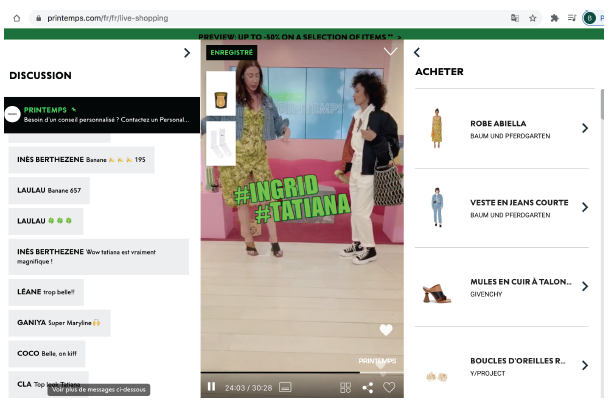 Printemps’ first live shopping session on Printemps.com
Printemps’ first live shopping session on Printemps.comSource: Company website[/caption]
One-to-One Sessions
One-to-one livestreams take a personalized approach to connecting with consumers, creating an interaction between the brand and the shopper that is more akin to the in-store shopping experience, involving a conversation with a store associate. The livestream host—brand representative that may be a store associate—is dedicated to one viewer at a time; this approach works particularly well when promoting high-cost products such as electronics, home goods and luxury products, as the associate can provide in-depth product details and recommendations that are tailored to each shopper’s needs.
- On April 29, 2020, electronic retailer Currys PC World teamed up with livestream e-commerce innovator Go Instore to power its live shopping experience. The format enabled store staff to serve customers remotely while working from home amid pandemic-led temporary store closures.
 Currys PC World launched a one-to-one livestream service on its website
Currys PC World launched a one-to-one livestream service on its websiteSource: Company website[/caption] 2. Choose the Right Livestream Hosts
Livestream hosts are essential in attracting a wide audience and creating an authentic connection with viewers, but they must have sufficient knowledge of the featured products to effectively drive sales. The goals that a brand or retailer wishes to achieve through a livestream session should inform their decision on type of host they use for each session.
Influencers and celebrities bring in their own established follower and fan bases, boosting brand exposure. They also typically create a sense of excitement in the lead-up to an event, with consumers themselves promoting the event by sharing it with friends on social media, for example. However, charismatic company founders, knowledgeable store associates or even customers can make effective livestream hosts, as they are more passionate about the company’s products. It is critical for hosts to communicate genuine enthusiasm to the audience in order to create a strong customer relationship. The real-time aspect of livestreaming also requires the presenter to be confident and approachable.
Founders and C-Level Management
Founders of brands and top executives have a competitive edge in promoting a brand’s products or services: Their status and reputation attracts viewers and they have the final say on heavy discounts.
- On June 10, 2020, Kevin Wang, CEO of Chinese electronics company TCL Technology, presented a range of home appliances on e-commerce giant JD.com’s JD Live platform. Wang offered exclusive discounts and deals, and the session attracted 2.5 million viewers.
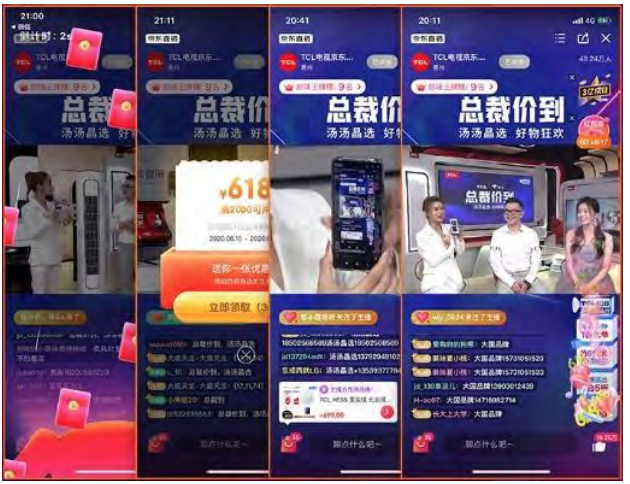 TCL’s livestream session on JD Live
TCL’s livestream session on JD LiveSource: JD.com[/caption]
- On July 15, 2021, celebrity and businesswoman Kylie Jenner hosted the first live shopping event on KylieCosmetics.com to mark the launch of the revamped Kylie Cosmetics range. Jenner demonstrated some products, and links to purchase appeared on viewers’ screens during the livestream, allowing viewers to purchase products without interrupting the experience. By hosting the livestream, Jenner tapped her own existing fan base in addition to interested beauty shoppers. Several products sold out within two hours of being promoted on the livestream.
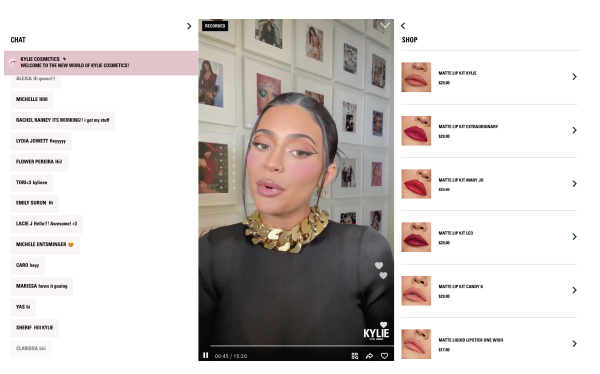 Kylie Jenner showcased Kyle Cosmetics products in her brand’s first livestream session
Kylie Jenner showcased Kyle Cosmetics products in her brand’s first livestream sessionSource: Kylie Cosmetics[/caption]
Associates and Micro-Influencers
Store associates and micro-influences are arguably the most relatable hosts for average consumers, enabling them to build shoppers’ trust.
- On November 25, 2020, JCPenney debuted “JCP Live,” a livestream show designed to offer shoppers insights into popular products. Store associates, bloggers and micro-influencers filmed live segments from their own homes, with each host presenting a curated selection of products in specific categories.
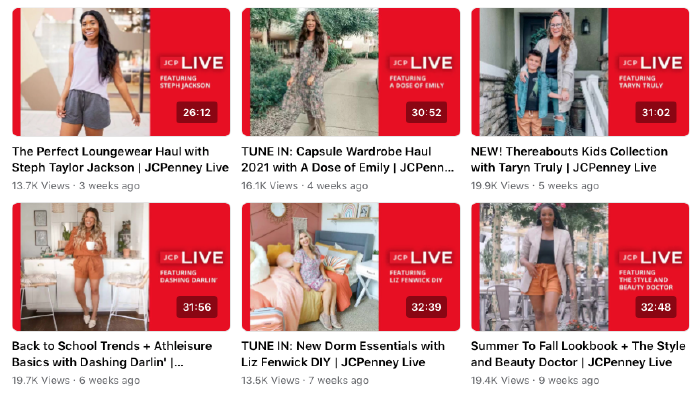 JCPenney’s themed live shopping sessions, hosted by micro-influencers
JCPenney’s themed live shopping sessions, hosted by micro-influencersSource: Facebook/JCPenney[/caption] 3. Drive Authentic Conversations
Building on the importance of choosing the right livestream hosts, brands and retailers should drive authentic conversations between viewers and hosts as well as among consumers. Authenticity builds consumer trust, making them more likely to make purchases and engage in future sessions.
Honesty from hosts when testing out products and relatable comments through live chat functionality build credibility for a brand and can be more valuable than product descriptions or photos in influencing viewers’ purchase decisions. In addition, the livestream location is key: Presenting a livestream from a host’s own home, for example, allows viewers to “peer into the life” of the livestreamer and can establish a stronger emotional connection.
Furthermore, a key element of live shopping is that it provides consumers with the opportunity to get to know and brand and their products better: Discovering new products and learning more about products are among the top reasons for watching a livestream, according to a survey of US consumers conducted by Coresight Research in March 2021: More than one-third of respondents who had watched a shoppable livestream cited each reason. It is therefore important that livestream sessions are informative, and answering consumers’ queries through live chat is a key way of achieving this.
- Read more about social commerce in the US in our separate report, US Social Commerce Survey 2021: The Impacts of Social Media, Influencers and Livestreaming on Shopping Behaviors.
Brands and retailers should focus on making livestreaming content personal and relatable, with the hosts sharing their own opinions on products.
- On July 8, 2021, The Paisley Heart, an online boutique based in Texas, US, launched daily live shopping sessions on Facebook by partnering with CommentSold. The boutique responded directly to shoppers’ inquiries and sent links to purchase relevant products. According to The Paisley Heart, the series saw the company drive $192,000 in monthly sales, on average, and accumulate 26,000 Facebook followers. Other brands that have used CommentSold’s platform include Deep South Pout, Erin Lane Bags, Loved by Loveless and Royalty Bling Rosses.
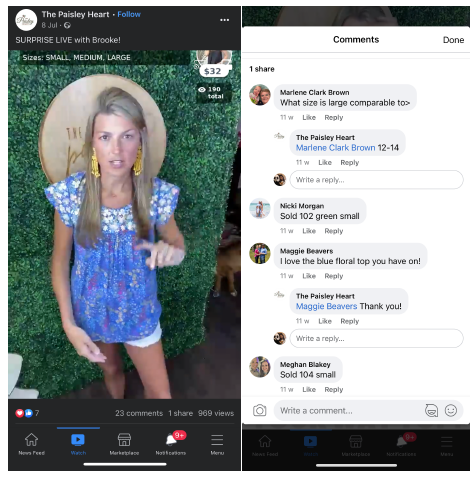 Business owner Brooke Howerton hosts a live shopping session through The Paisley Heart’s Facebook account, with live comment functionality
Business owner Brooke Howerton hosts a live shopping session through The Paisley Heart’s Facebook account, with live comment functionalitySource: Facebook/company website[/caption] 4. Promote Live Shopping Events Through Communities
Livestreaming should be integrated into social media strategies that promote brand and community building, in order to maximize viewership for live shopping events while showcasing brand values among a relevant and engaged target market.
- On June 15, 2021, Macy’s collaborated with Refinery29 and tech partner Everywear to host a session on Zoom and Instagram Live showcasing current fashion trends and make-up tips. Refinery29 editors shared their personal style picks and interacted with the live audience—an engaged community of fashion shoppers—through customized recommendations. As products were featured in the livestream, images of the items and links to product pages were updated in real time on the digital storefront. According to the Macy’s, it saw a 45% purchase conversion rate after the show.
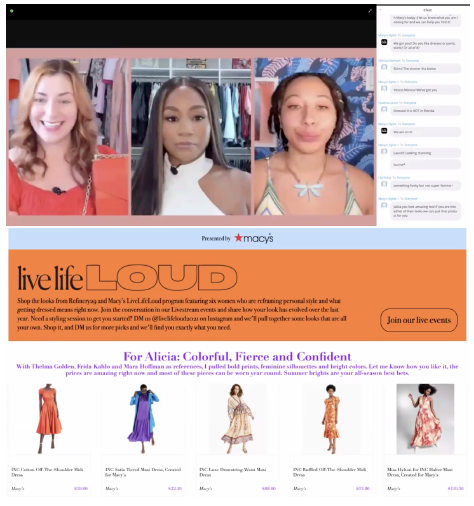 A digital storefront is updated in real time as products are featured in the livestream
A digital storefront is updated in real time as products are featured in the livestreamSource: Everywear/Macy’s[/caption]
- On November 19, 2020, women’s wellness and personal care brand, Love Wellness launched a live shopping session on Ulta Beauty’s Live Cast, a live shopping program focused on spotlighting new products, and on Instagram Live. More than 200 customers tuned in for the session and joined the conversation on sexual health. The event provided attendees the opportunity to have an honest dialogue about a topic that can be perceived as taboo.
 Lauren Bosworth, CEO of Love Wellness, hosts a live shopping session on Ulta Beauty channels
Lauren Bosworth, CEO of Love Wellness, hosts a live shopping session on Ulta Beauty channelsSource: Love Wellness/Ulta Beauty[/caption] 5. Communicate Brand Stories
Brand storytelling is important in expanding market reach and connecting with consumers. It enables brands to share their history, values and mission with existing and potential customers, which can support emotional engagement and foster loyalty among shoppers.
- On June 15, 2021, artisan beauty brand Beekman 1802 hosted its “Blooming Skin Show” live shopping event in partnership with tech provider Livescale. The session was hosted on the brand’s website as well as broadcast through Instagram Live and Facebook Live. The brand featured photos, animations and pre-taped video assets in the hour-long live program and shared personal stories on the creation of its products. The conversion rate during the event was 35%, according to the company.
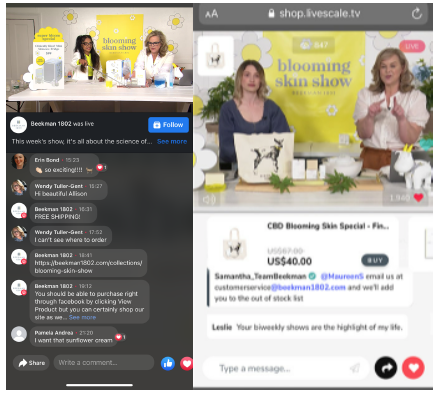 The Blooming Skin Show on the Beekman 1802 Facebook account (left) and on the brand’s website (right)
The Blooming Skin Show on the Beekman 1802 Facebook account (left) and on the brand’s website (right)Source: Beekman 1802/Livescale[/caption] 6. Have a Dedicated Team for Live Shopping Programs
Although livestreaming is an accessible channel for brands and retailers—it can be done with one host and a camera—companies that wish to embed livestreaming e-commerce into their operations should have a dedicated team. This is because the research, planning and logistics required to run a successful livestream event is labor-intensive. However, the team does not have to be fully in-house: Brands and retailers can work with agency experts, third-party service providers and influencers to set up and run livestreaming events.
Another important consideration is how brands communicate with viewers during events; it is advisable to have customer service staff responding to questions about products and dealing with order queries in real time, in order to maximize shopper engagement and purchase conversion.
- In May 2021, Gerry Weber, a German fashion manufacture and retailer, presented a live shopping program on its website and social channels in partnership with tech innovator MuSe Live. The retailer’s dedicated team worked behind the scenes to support video shooting and live editing.
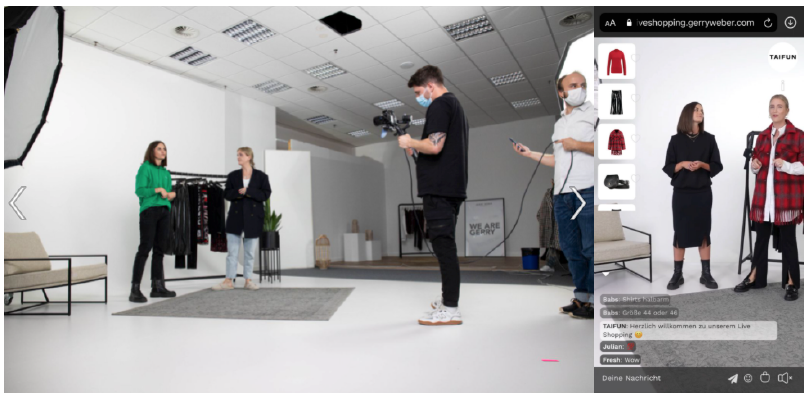 Behind the scenes of Gerry Weber’s livestream (left) and the live show (right)
Behind the scenes of Gerry Weber’s livestream (left) and the live show (right)Source: LinkedIn/MuSe Live[/caption] 7. Set Recurring Livestream Schedules
Having a regular cadence of livestreaming sessions is a key strategy for brands and retailers to build a base of repeat viewers, fostering new consumer habits. Regular live-shopping schedules enable brands and retailers to become an ongoing part of their customers’ lives.
- In April 2020, Samsung Germany launched live shopping as part of its digital campaign. The brand scheduled one-to-many sessions on a daily basis, which covered a range of themes, topics and products.
 Samsung Germany launched a regular livestream series
Samsung Germany launched a regular livestream seriesSource: Company website[/caption]
What We Think: The Dos and Don’ts of Livestreaming
Best Practices (the Dos)
- Be spontaneous and authentic. Live shoppers won’t make a purchase based on how well a product description was scripted. Instead, conversion is influenced by emotions in the moment. In a practical sense, brands’ livestreaming strategies must reinforce the product’s value proposition, which means making thoughtful choices not just about prices but also about personalized offers, and shipping times and fees. In an emotional sense, hosts that engage with viewers as well as entertain them are more likely to drive sales.
- Use people who care about the brand. People who are passionate about the brand, such as in-store associates or micro influencers, make effective livestream hosts, as they can communicate genuine enthusiasm to the audience. The livestream shopping format combines the best of online and offline shopping, as it enables both product discovery and an emotional connection.
- Test and refine. Finding the best livestreaming format takes a test-and-learn approach. Management teams should have a flexible mindset so that livestreaming strategies can adapt as the brand learns what best resonates with its target consumers. Companies can start with pilot sessions in a specific product category or channel. Brands and retailers should track progress and be responsive to new ideas and learnings from mistakes.
Pitfalls To Watch Out For (the Don’ts)
- Don’t lower prices just for the sake of promoting live shopping. Reiterating one of the points above, consumers’ triggers to make a purchase can vary, particularly across products and categories. While seasonal discounts or product launches are reasonable promotions that can drive consumer excitement, consumers remain mindful of brand authenticity and product quality, and their perceptions of both could be undermined by drastic price cutting. We believe that the positioning of products and the charisma of the livestream host are more effective drivers in the success of a livestream than rock-bottom prices.
- Don’t see it simply as a sales tool, but a brand story. The lines between physical stores, e-commerce and direct-to-consumer channels are becoming increasingly blurred, particularly with the emergence of live shopping. Brands and retailers are recreating every step of the in-store shopping journey online, from discovery and browsing to purchasing. Livestreaming e-commerce enables brands and retailers to connect with customers in a more meaningful way than simply through e-commerce websites, which is valuable in cementing customer loyalty.